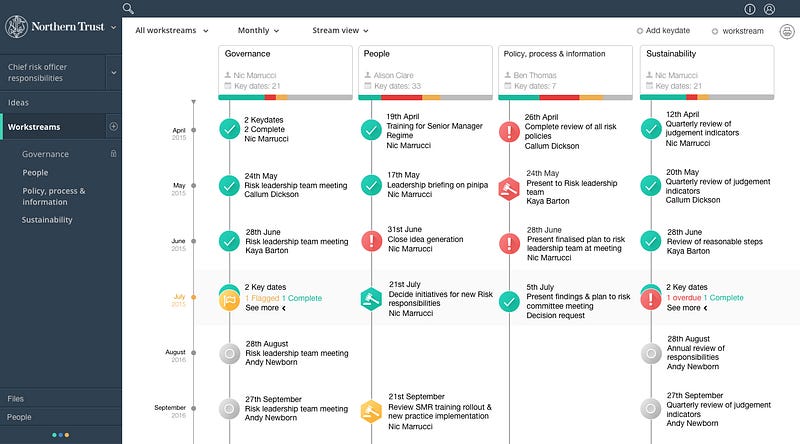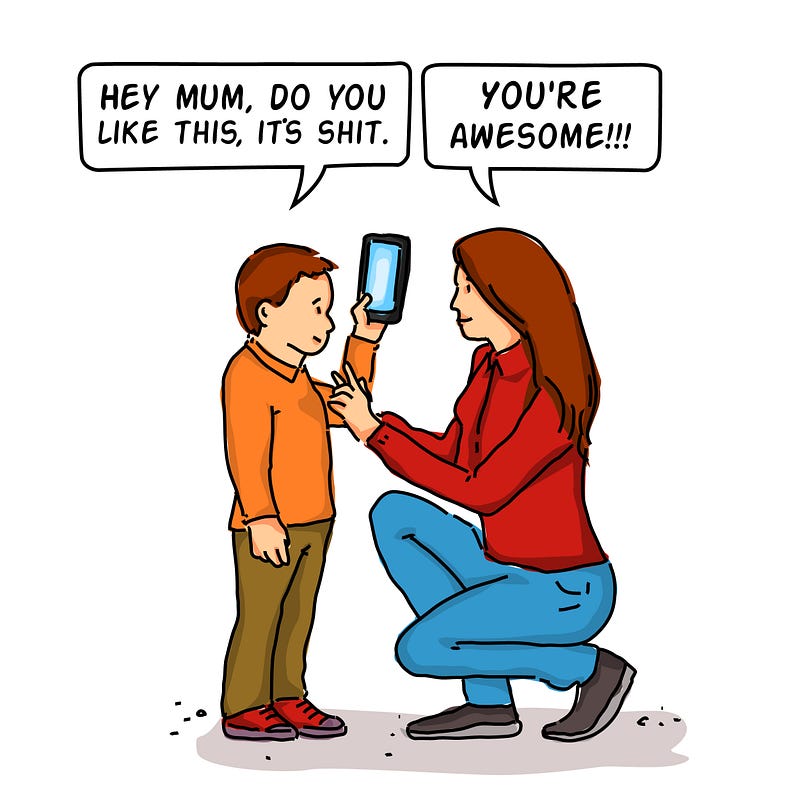It’s taken me some time to come around to writing this.
It’s been 12 months since my wife Faith (founder) and I (cofounder) admitted defeat and told our staff, investors and customers that we were shutting the doors on Pinipa. Although it was in some ways a long time coming, it was still incredibly difficult to let go of something that we had put so much into for 5 years and say goodbye forever.
What made it even more difficult for us is that my wife, Faith and I were cofounders of the business. Faith started the business while on maternity leave with our first child, so the business was essentially our other child.
While it is still reasonably fresh (but not so much to be raw!) I wanted to share the mistakes we made and the things we would do differently should there be a next time. I hope this will help people who are looking to do a startup or is deep in the startup ‘trough of sorrow’.

Pinipa — a tool for simple oversight of complex initiatives
If you really want to do a startup, make it something you’re passionate about
This is something I say time and time again to friends and colleagues who tell me they want to do their own startup. I verge on sounding bitter when I bring it up but you have to really, really want to make a difference. Startups are about stamina, particularly when you’re in the “trough of sorrow” and coming to the realisation that it takes at least twice as long as you expect to get traction. When the stakes are high, you had better believe in what you are doing.

Something we didn’t consider before starting
Personally, I did originally believe in what we were doing, but as Faith was the original problem owner I was always buying into her vision. I had never truly experienced the problem that we were trying to solve and was living it through her story telling. As we hit tough times and started questioning our existence, it was hard to channel someone else’s passion to motivate myself and be resilient. Had I truly experienced the problem and able to live the customer empathy, it would have been easier to continue to give it 150%.
Start with a clear problem, focus on a narrow market, and innovate
It’s easy to get carried away with your own fantasy of instant startup success. Unfortunately, generally all you hear about in the startup world is success stories, and having been part of a unicorn success story already at Yammer, it felt like the world was ours for the taking.
It was over 6 years ago that the startup idea took hold on us. What is hard to decipher in hindsight is whether I was more excited about the thought of BEING a startup, rather than DOING a startup. We thought we had a problem to solve at the time, but I didn’t really think of it as a problem, more like an opportunity. Our headline figure was that we were disrupting the management consulting industry, worth $8b annually in the UK. And if we’re going globally, we could be a $1b business. Like so many founders, we believed we too could be a unicorn.
With a working prototype and a big wide world in front of us we just raced ahead and started selling. Unfortunately our first customer’s requirement was different to our second customers requirement, and so on. We didn’t have a clear problem we were trying to solve, we were chasing traction and dollars.
Without a clear problem to solve, we were struggling to work out a clear market to focus on. Our first three customers were not aligned at all. A global recruiter, a regional county council and a national retailer. So it was hard for us to leverage any success between them and apply this back into the product. And because our sales pipeline was so broad we were never confident enough to focus 100% on a certain sector or industry, and it made it very difficult to work out the right pricing, messaging etc. When we did focus (at a later stage), we had already burnt through most of our cash which made it a do or die situation.
It is a classic example of the importance of focusing on a narrow market in the early stages, like Facebook did with their campus-only invites. Hindsight is wonderful, if we had our time again we would focus on one industry or a narrow segment of customers who were trying to solve a similar problem and use this to prioritise product before sales in the early stages.
Test your ideas beyond friends and family
We made a cardinal mistake from the beginning with our idea validation. Faith and I designed the prototype app using Faith as the subject matter expert with powerpoint wireframes. We then took the prototype to Faith’s friends in the industry. We received positive reviews mixed with outright admiration for being entrepreneurial.
What we have learnt since is that people are generally nice, and the way you ask those questions is incredibly important. What we didn’t validate is whether they would actually BUY the solution or if they thought it was viable in their organisations. Not only did this process get us biased results but it was entirely back to front, testing the concept of an app rather than validating whether the problem exists or is big enough to be worth solving.

Don’t be this kid
What we thought was product market fit wasn’t actually at all. With our powerpoint prototype getting positive reviews from friendly industry contacts we built the “MVP” through an outsource company in India. From that initial build we managed to get our our first paying customer, an enterprise sized and FTSE listed recruiter paid $5,000 to run a pilot. To us, this was market validation and with interest from other enterprise companies wanting to do pilots I decided to go full time as well so we were living off our savings.
It seems crazy now to look back at the situation we were in. At the time between the two of us we had been earning upwards of $500k — which meant we had some money in the bank and the luxury of being able to choose to stop working. We gave up our stability and income while paying a full time developer along with child care costs and our mortgage in London. Our personal savings burn rate had about 6–9 months before we needed either significant revenue, investment or we just called it quits.
Over the next 6 months we hustled, rebuilt the product with a local developer and managed to get pilots from more high profile customers. With strong reference customers we managed to close our seed investment round with Passion Capital, a high profile and very well respected early stage VC, and several experienced angel investors… with only 1 month of personal cashflow left. We’d made it!
But actually we hadn’t. We realised shortly after that those initial pilots did not mean we had product market fit, and we went back to the drawing board yet again on the product design. This time we did it with a UX designer leading the way — something we should have done much earlier had we had more product experience.
It is incredibly difficult to tell when you have actually achieved product market fit without the benefit of hindsight. The important thing to look for is how your customers would react if the product was taken away. If they can’t live without you, then you know they are genuinely getting true value from it.
When it comes to enterprise, do product first and sales second
This actually applies to all products, but it’s particularly important when it comes to enterprise customers. Simple, beautiful and well designed single purpose applications can work well in teams in large enterprises. But when you scale beyond your initial use cases to a broad enterprise sale, enterprises quickly nail down any new vendors to align with their procurement processes and technical requirements. Particularly if your going above a budgetary threshold, procurement requirements like credit checks, references, financial statements, business cases, budget cycles and open tenders can severely delay an enterprise sale. In addition, you will have to do technical and security assessments which are usually the same requirements for big vendors like SAP or Oracle and entirely not suitable for a small cloud-based startup. These hurdles like SSO, data ownership, encryption and integrations all hamper your ability to generate revenue quickly.
All of these issues can be overcome with time, and enterprises are generally getting better at this. It’s a hard balance, but a lot of this selling time is slow work and in the early days, it pays to have a solid product before aspiring to go for an enterprise wide sale. Spending that time nurturing your initial champions and small business units will pay off in the long term.
We were great at getting initial pilots with organisations and we embraced their enthusiasm readily. Taking that leap to a full enterprise sale was something that certainly took longer than expected and required a level of maturity in the product that we struggled to achieve with constrained resources.
Raising money isn’t a reason to spend money
We fell into a trap, we thought we have had some traction, we had raised $750,000 from amazing investors and our instinct was to go big. We saw all of these incredible startups around us who were also part our VC family growing like crazy. It seemed like their seed rounds turned into series A,B,C all within months of each other.
After closing our funding round our team grew to 9 employees and our ambitious revenue growth plans quickly came under pressure. We were trying to ramp up sales on a product that wasn’t ready for scale and we were not ready to support an enterprise-wide customer. We made a hard decision to pivot our platform to something we thought would be more easily consumed by the market and downsized our sales team while working on our product-market fit. Unfortunately we had already burned a lot of time and energy, and money, with the wrong product strategy which left us in a difficult situation.
When you raise money, you are either implicitly or explicitly expected to spend that money to ramp up quickly. Our lesson was that we should have waited until our customers LOVED our product before trying to ramp up.
Know when to quit
This is one of the hardest decisions we had to make. If you follow the principals of The Lean Startup we should be celebrating failing fast and failing cheap. In reality, after putting years of our family life into it and with investors we truly valued who had given us their money because they believed in us, making this decision was far from a celebration.
This is difficult to reflect on as we genuinely had a business worth pursuing, with plenty of traction with customers such as River Island, National Grid, Microsoft, LinkedIn, GlaxoSmithKline, Deloitte, PwC and Capita. Just pulling up stumps when you have active customers is not quite so common in startup land.
In the end, the decision was mostly made for us. A combination of Brexit and the subsequent snap election in the UK meant two of our main contracts, which we needed for our next investment round, were put on hold with the freeze in government spending. And around the same time Faith delivered two beautiful twin babies, which changed a lot of things, not least our risk appetite. We at least had the foresight to make the decision while we could still pay out our loyal employees, return some money to our VC and gracefully wind down.
While this clearly wasn’t an easy thing to do, we truly felt that we had done everything in our power to make it work and unfortunately luck just didn’t go our way when we needed it to.
While it wasn’t the unicorn story we were hoping for, we are still very proud of what we did achieve.
Was it worth it?
Absolutely. It was a pivotal moment in our lives for both Faith and I, which has built strong foundations for the next stage. We learned SO much from our experience, the practical lessons and foresight we have gained would be hard to replicate in an MBA or corporate job. The same goes for our small, initially inexperienced team. All have gone on to bigger and better jobs and that means a lot to us.
Sometimes it’s hard to focus the positives beyond the negatives, but what we managed to achieve with a crazy vision and some seriously hard work is incredible. We are hugely proud of what we created and we still have people asking us today if the solution is available as the problem has not gone away. We had a great idea, a great team, great investors and a big problem to solve, we just didn’t execute in the right way until it was late in the game and needed some serious luck on our side.
The startup bug has not left us. Now we get to work in great jobs where we can hone our skills helping corporations innovate in the startup way. As for the next venture… who knows!
My biggest lesson, if you have an idea you are excited about, just do it.
____
This article was first published on Medium. I’m always up for a chat if you want to meet up on skype or over coffee in Sydney to talk about your idea or startup: [email protected]




















Trending
Daily startup news and insights, delivered to your inbox.